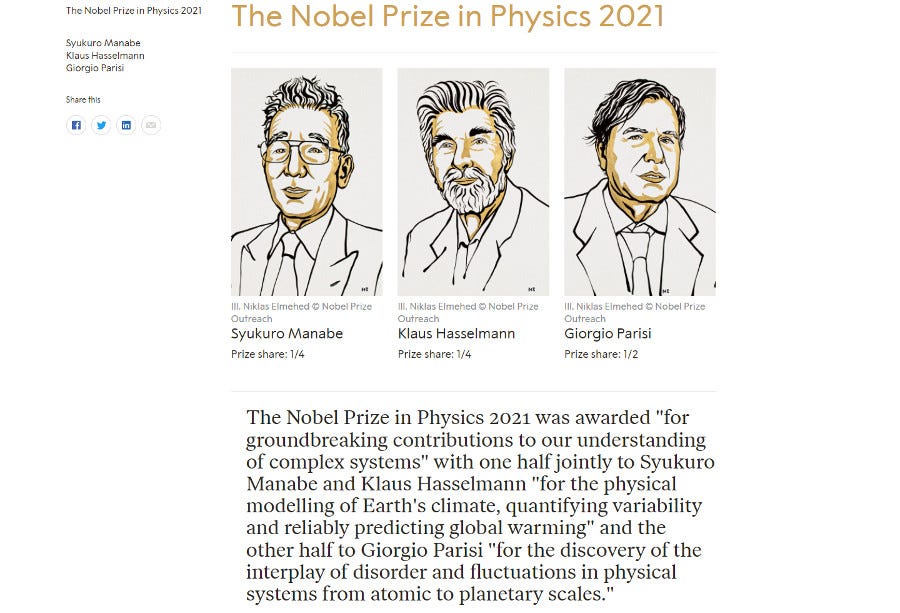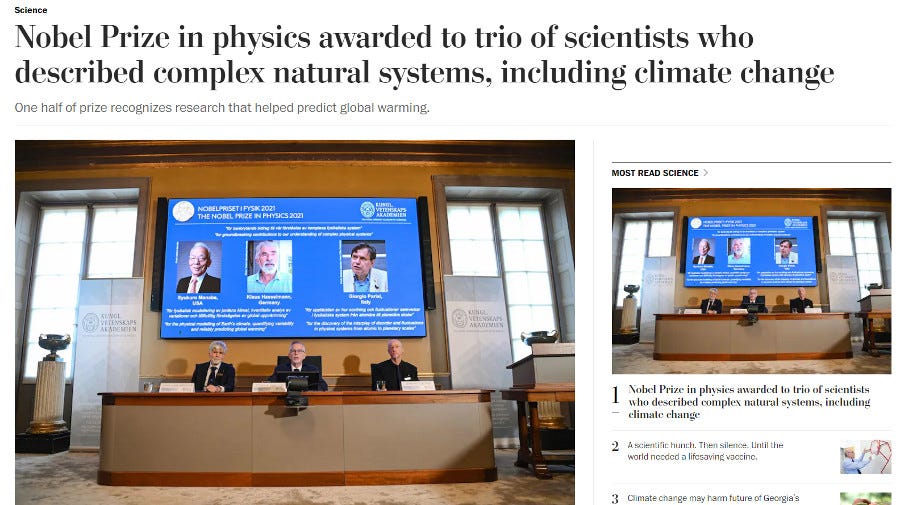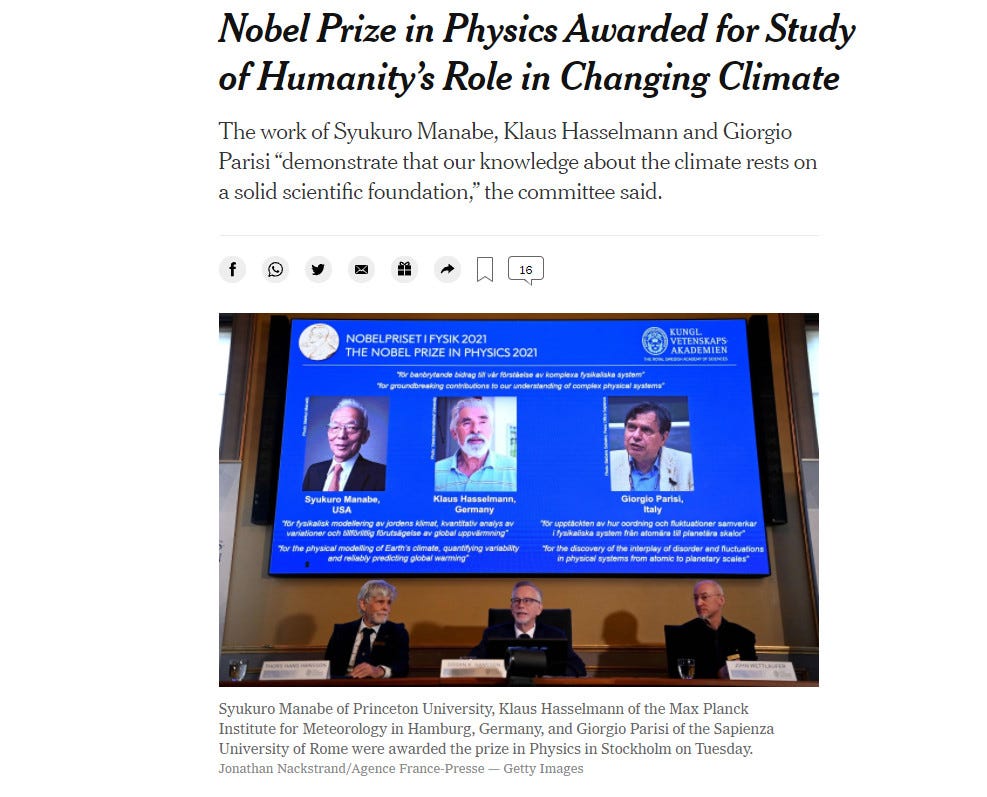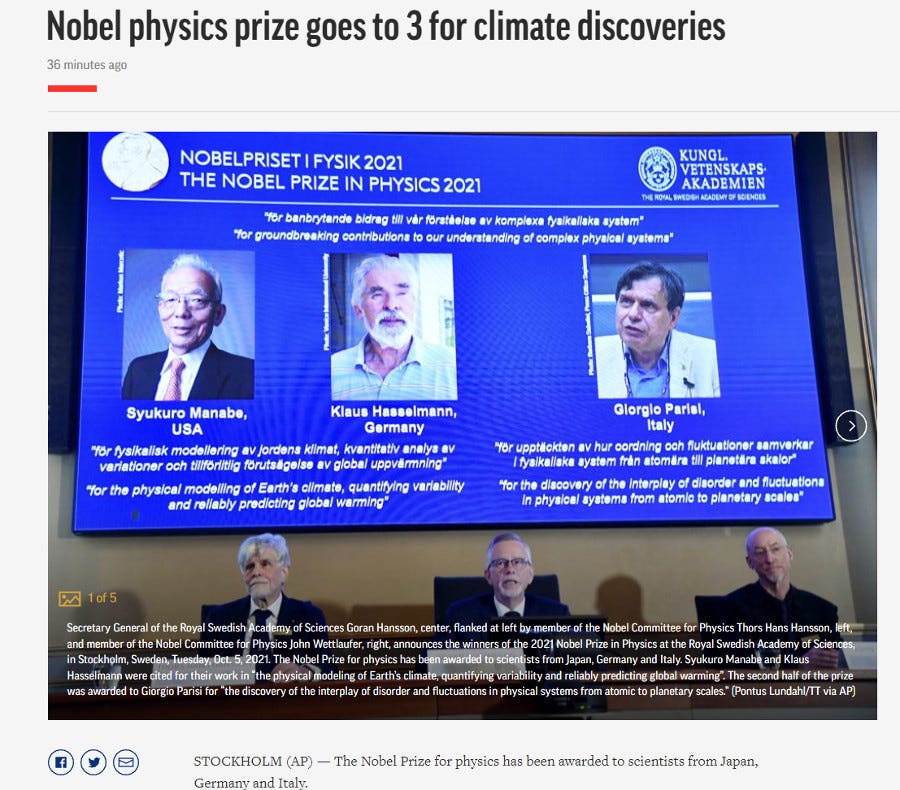The 2021 Nobel Prize in Physics was announced this morning, “for groundbreaking contributions to our understanding of complex physical systems.” The fine print says that this is to be split among three scientists for two different topics: half to Syukuro Manabe, Klaus Hasselmann won “for the physical modelling of Earth's climate, quantifying variability and reliably predicting global warming,” and the other half to Giorgio Parisi “for the discovery of the interplay of disorder and fluctuations in physical systems from atomic to planetary scales.” When they tweeted about this, they specifically cited Parisi’s work on spin glasses, which prompted me to tweet:


So, was I right? Well, let’s check in on my usual news sources. The best of the bunch, headline-wise, was the Washington Post:
They still push the climate angle much harder than the condensed-matter part, but it’s pretty much equal space for each laureate, so that’s fine.
Here’s the New York Times:
This goes much harder on the climate angle, with basically one sentence on Parisi’s work in condensed matter.
And here’s the Associated Press story:
Again, Parisi’s condensed matter work gets a single sentence. All three also quote Parisi answering a question about climate change at the press conference announcing his win.
(I should note that, as one might expect, Physics World does a much better job of balancing the story and putting everything in context.)
And, look, I realize I’m being a little unfair, here: headlines are written separately from the articles, and these are the rushed immediate new stories. The real test will be whether the longer explainer articles released late tonight or tomorrow will give significant depth to the really cool physics Parisi worked on.
I’m not really holding my breath on this one, because we’ve done this dance before, in 2016, when the Nobel went to Haldane, Kosterlitz, and Thouless for work on topology in condensed matter systems, and basically every story led with surprise that it hadn’t gone to LIGO, whose discovery of gravitational waves from the previous fall had been announced right around the time of the deadline for submitting Nobel nominations. That really annoyed me; on the bright side, the explainer post I wrote for Forbes once it became clear that nobody at a major paper was going to do a decent job of it was one of the most-read things I wrote that year.
As I said on Twitter, this might annoy me even more than the 2016 prize coverage, because the unity of the topic there meant that science writers had to talk about topology in condensed matter, even if it was disappointingly superficial. Pairing this with the climate stuff gives lazy journalists the out of filling their column inches entirely with detailed stuff about climate, leaving Parisi as an afterthought in his own Nobel coverage. And that sucks about as much as it’s possible for winning half-a-Nobel to suck.
This is particularly frustrating because it ties into a broader trend of dismissing physics outside of astronomy and particle physics as abstract and incomprehensible, when it’s actually just under-covered. Astroparticle physics isn’t actually any easier to understand, it’s just familiar, because there are a zillion popularizations out there already to crib from. Statistical and condensed-matter physics have great practical consequences, but hardly anybody writes about them at a general-audience level, so anyone who needs to do so is starting from almost zero. But that becomes self-reinforcing, as the lack of pre-existing material pushes journalists with deadlines toward topics that are easier to write about, namely astronomy and particle physics. And, now, climate change.
What I would really like to see, given the very different topics here, is for the major outlets to do two stories, one from somebody who knows the climate modeling side, and one from somebody who can do a decent job with the condensed matter stuff. What I expect we’ll get, though, is at most a couple with a 2/3rds-1/3rd split, and a lot that are 95% climate science, with a “Oh, yeah, there was this Italian guy who did something with spins, and answered a question about climate at the press conference” tacked on at the end.
I am not at all familiar with the physics of spin glasses, but I’m in the process of digging into that and trying to put something together for (hopefully) tomorrow, probably at Forbes because it has more reach than this Substack. And when I do, I’ll be sure to tack on “And some other guys used computers to predict climate change…” at the end. I really wish I didn’t have to, though.
That’s a bit of a grumpy rant, but if you’re not too put off by it, here’s a button you could click to get more:
and here’s one if you want to push this on somebody writing a big long climate-heavy story to encourage them to do better:
If you want to point me toward better coverage, or good resources for understanding spin glass physics, the comments will be open.








When I saw the announcement this morning one of my first thoughts was that I don't envy the science journalists who are now stuck with the job of trying to explain spin glass theory to a general audience. The stuff that Parisi is famous for in particular ("replica symmetry breaking") is just pretty arcane even by the standards of theoretical physics.
Here's a decent short article about what spin glasses are and why the became interesting to people in fields outside of condensed matter: https://wpmedia.wolfram.com/uploads/sites/13/2018/02/20-2-4.pdf
>And when I do, I’ll be sure to tack on “And some other guys used computers to predict climate change…” at the end. I really wish I didn’t have to, though.
This would be a great addition